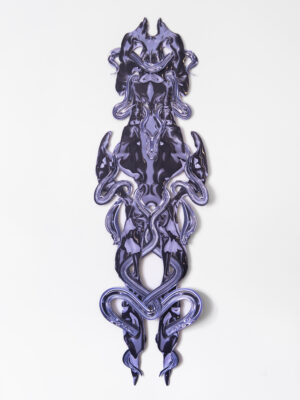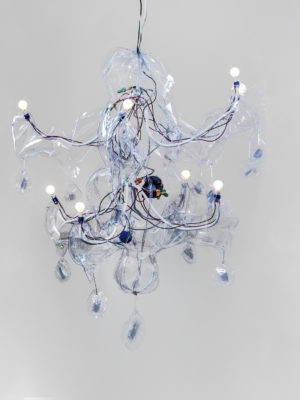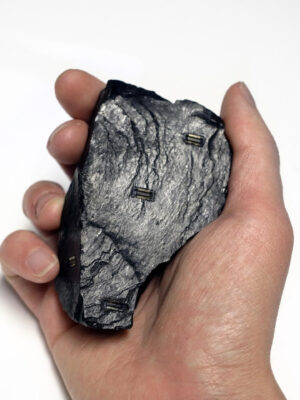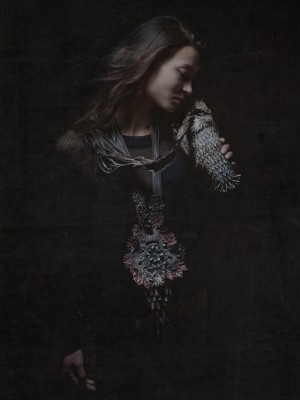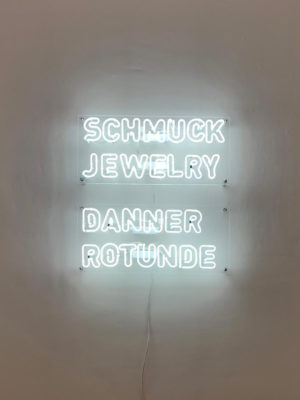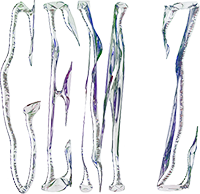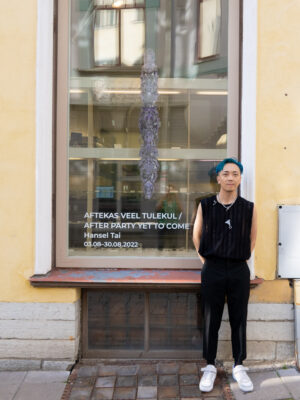
A-Gallery is a unique space for art jewellery in Estonia representing over a hundred artists from the local cultural field. The gallery’s purpose is to showcase professional artists and designers, creating an outstanding display of jewellery, unique pieces and exhibition works.
The artist talk with Hansel Tai was conducted by Estonian interdisciplinary artist and writer Urmas Lüüs. The artist talk was held in A-Gallery in connection to Hansel Tai’s exhibition AFTER PARTY YET TO COME.
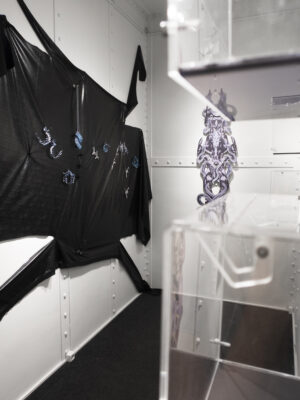
H: I was born in South China and after I decided I wanted to study jewellery I moved to Beijing where I obtained my BA in 2016 from the Central Academy of Fine Arts (CAFA). After graduating I knew I wanted to continue and somehow I ended up in Estonia and I continued my artistic research at the Estonian Academy of Arts in Tallinn. After receiving my master’s degree I decided to stay in Tallinn and create my studio here.
U: When did you come to the realisation that you wanted to study jewellery?
H: In general, since I can remember I’ve always been interested in art. I drew a lot as a child. I knew I would go study at an art academy. Initially, I wanted to study sculpture, but someone I knew was studying it at one of the top art academies in China and she warned me that all the casting work and lifting is very labour heavy and you have to be very physical to do sculpture. I was worried that I couldn’t physically do it. My understanding of jewellery was that it is a small-scale sculpture, so naturally, it was my next option and that’s how I ended up in the jewellery department.
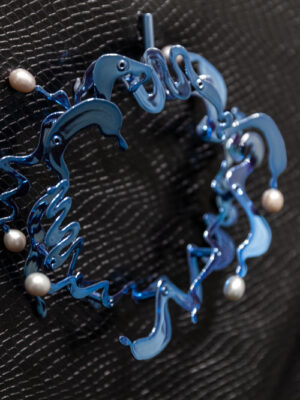
U: I’ve seen pictures of admissions and exams in China of thousands of people in the hall drawing. Was this your experience as well?
H: In mainland China, getting into an art academy is very different from anywhere in Europe in my experience. You have a separate national art exam where you do have thousands of people in a room drawing still life etc. After that, you get the qualification that you are good enough to apply to an academy and then you can take the academy’s exam. So you have multiple exams happening.
U: Why did you choose Estonia?
H: It had to do with the introduction of your jewellery department during my bachelor’s degree. My professor had studied in Germany and when she came back to China she founded the contemporary jewellery department. She was one of the pioneers of bringing a contemporary approach in jewellery to China. I feel like art jewellery and contemporary jewellery is a very small field in China and I happened to discover Tanel Veenre’s work at the very beginning of my studies so I’ve always liked his work. After graduating with a BA I had to think about where I wanted to do my master’s and my options were either in Tallinn at the Estonian Academy of Arts or in Amsterdam at the Sandberg Instituut. In the end, I decided to follow my favourite artist instead of a bigger or fancier academy.
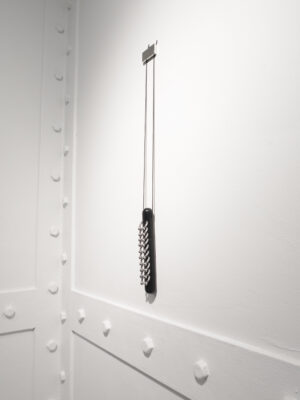
U: You did however study in Amsterdam as well at the Gerrit Rietveld Academie. Was it very different?
H: It was different and similar in a way being at Rietveld. There are some similar personality traits in jewellers so no matter which academy I go to I can always see the people have some characteristics in common. I feel like a lot of jewellers are a bit shy and reserved and I think it might be one of the reasons why they make jewellery. You don’t have to be merged together in the same space with your art. Of course, there are people who use their bodies to make jewellery but there are a lot of people who are more interested in the material and there is this opportunity to detach yourself from your work. So I think this element has always been a presence no matter where I’ve been. Also, I was always familiar with working in a studio with a small group of people so you get to learn about everybody’s work and their different approaches so from the beginning you understand the uniqueness of everybody and that’s the important part.
Comparing studying in Tallinn and in Amsterdam there’s also of course the difference in the culture attached to the country itself and the general art scene which I felt even more than the difference in the art departments.
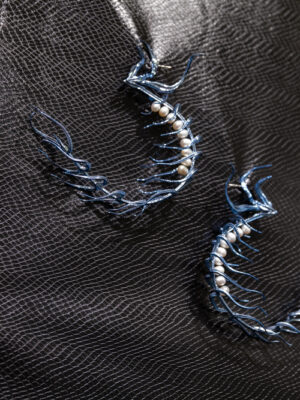
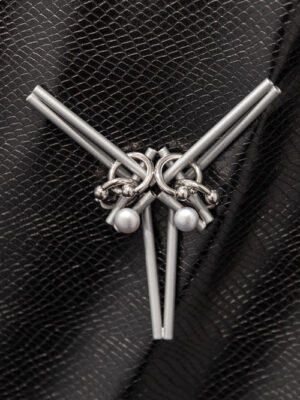
H: The pieces in this show are very specific for me. I am reimagining the Southeast Asian deity. For me, this is a queer deity, a queer god and I’m reimagining all the magical weapons from the mythology so if this exhibition was a movie it would be dystopian science fiction. The deity is called Nezha or Third Lotus Prince and each exhibition piece is titled as a magical weapon from the myth. Actually, all my work is sort of post-apocalyptic, alien, and tentacle horror inspired, so as a movie it would be something like that.
The reason I’ve wanted to reimagine these themes this way is that I love the traditional aesthetic of the deity appearing in paintings and sculptures but I’ve felt like it’s also been very limited by its time and it has stayed in the past. As a god, they should transcend time so by abandoning the traditional aesthetic I’ve tried to imagine what they would look like if they existed in a timeless way, in the past, present, and also in future.
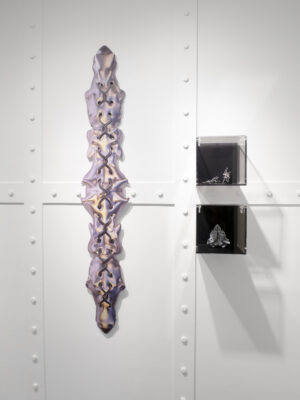
H: Yes, I am a cybersmith. I love this kind of stamp that I’ve put on myself. When people say they are a blacksmith, goldsmith, silversmith, etc they are mostly talking about the material they are using. So in my case, I’ve called myself a cybersmith and I’ve wanted to communicate with this concept because I’m from the generation where the Internet has always been there. I’ve been surfing online more than I’ve been reading books or much longer than I’ve been working with metal, so in a way, this is the medium where I’m most experienced. This is why I call myself a cybersmith as that’s the most common medium I’ve been using. The challenging part of this is figuring out how to present and materialise something virtual.
U: Yes, we have witnessed that the real, touchable, mundane reality has become just one layer of different realities and we can move between those realities. In the end, your pieces are actually wearable, they are material, textured, and touchable. Even though you talk about the virtual world and the influence of the Internet, craft-wise you still use quite a lot of old techniques, you cut stone and do complicated soldering and rivets. Do you feel there is a conflict between these centuries-old crafts traditions and the other ephemeral, untouchable, virtual world that inspires you?
H: I don’t think there is that much contrast in the two sides you mention, as in jewellery we have always dealt with abstract and intangible concepts about love, eternity, and commitment. These are very similar to what we are trying to discover in virtual culture.
Actually, the project that this exhibition is also part of, some of the pieces are virtual and some are physical. As the space in the VAULT is small, I picked only the physical pieces to be exhibited, however, there are pieces that as a whole included both physical and virtual sides. For example, there is a spear brooch, of which the head of the spear is exhibited here in the VAULT but the shaft for it is actually a virtual piece. I showed this project in Rotterdam before, so it was half projection that was added to the physical pieces.
I’ve also always been very inspired to transfer the virtualness to the physical object – the super shiny surfaces, the fluidity of the virtual space, etc. I’ve always been interested in materialising this. That’s why I’ve chosen to chrome so many surfaces to achieve this 80s or 90s kind of imagination of the future, which was then limited by technology – everything had to be less detailed and the special effects back then were super fluid and shiny and lacked the correct texture. When you saw a space worm back then the skin was too slick and shiny, almost like glass, and lacked the actual texture you see in today’s blockbusters. I like this kind of detachment of retro-futurism, where there was a fascination with the future but it was not necessarily the future that will be.
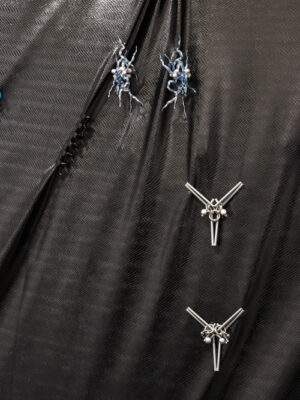
U: Looking at the pieces I also see them as objects of fetish, there’s a lot of piercing and some hooks on the walls. If I’d imagine them in a movie, then this movie would probably be shown very late in the evening or have the parental advisory marking on it. It’s not a porn movie but this movie would not be suitable for people under the age of 16 or something. Where does this element in your work come from? Is it also part of the futuristic imagination?
H: It is an aesthetic I’m drawn to, it’s my personal aesthetic. I think jewellery is a very sexy thing and the creation of it comes from a burst of desire. I like the physical attractiveness of the objects. For me, it is being true to myself. I’ve always said that I make pieces I myself want to wear and I want to feel like I become something after wearing them.
U: When I think of this hypothetical movie, it’s quite dark, for sure not a Disney movie, and probably doesn’t have a happy ending. It’s a very dark vision of the future, a sort of dystopian or apocalyptic movie. You also mentioned the fall of mankind in your master’s thesis where you looked at the same topics we’ve been discussing. Why is it so dark, why do you see the future ending up rotting somewhere in black soil?
H: For me, this is the future that is more likely to happen. Of course, no one really knows what the future will be but for me, this vision seems the most plausible. For me, it’s quite shocking that there are some people who believe that instead of a dystopian one we will have a bright future. I can not imagine this future coming into existence. For me, this dark and apocalyptic future is what it is. I think it’s hard to ignore all the signs today pointing towards that kind of future. It’s not necessarily a bad thing because I think humankind will eventually evolve and become something new. I mean we’ve discovered that the majority of us have plastic in our blood nowadays. However, we’re still okay and surviving, we are very adaptable and always evolving. It might be a dark or dystopian future for mankind of the now but it might not be that for mankind of the future. I would like to live in this kind of future in a way. It has an allure and attractiveness for me.
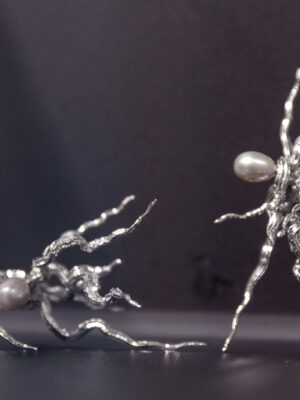
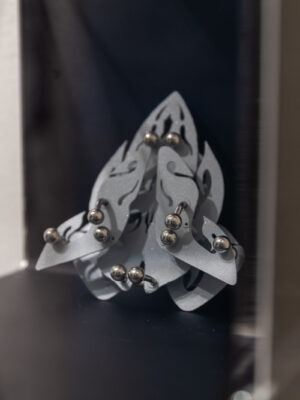
H: It’s such a specific experience to have an exhibition at the vault space in A-Gallery and I knew that my show was gonna happen during summer. So for me, it’s very much about the here and now as well as the connection between summertime and celebration/parties. At the same time, this exhibition represents the several projects I’ve been working on for the past years, and I kind of mixed and matched them together here in this one show. I didn’t want the projects to be restrained to their individual concepts but at the same time, I feel that because they are all made by me there’s an overlapping theme behind all of them. So this exhibition is also a way for me to pause and reflect on the work I’ve been doing for the past years. Each exhibition is a self-reflection and a ceremonial momentum where you get to pause and see what you have created and where you will go from there. The title represents the moment where you’ve just had a huge party and you step outside, breathe in the cold air and you’re standing there with your own thoughts about everything that just happened. And you are not done but are still looking for something more. That’s what I was thinking when I was creating the show.
U: What’s your next milestone? Now that the COVID crises are hopefully coming to an end and the world is opening up again, we just had Schmuck again this summer over a long time and so on. What are your plans, and where can we see your pieces next?
H: My plan is to keep working. You always want to do so much and I feel like there are some projects that I’ve been developing that need more time, so that’s the plan for now. I’m very happy that the world is slowly opening.
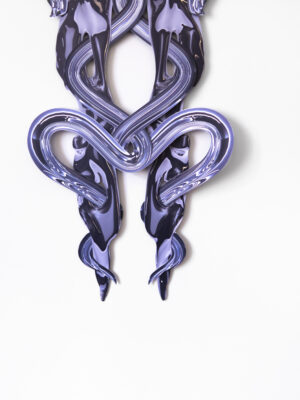
More about Hansel Tai’s exhibition AFTER PARTY YET TO COME at A-Gallery here: https://agalerii.ee/en/hansel-tai-aftekas-veel-tulemas-en/
